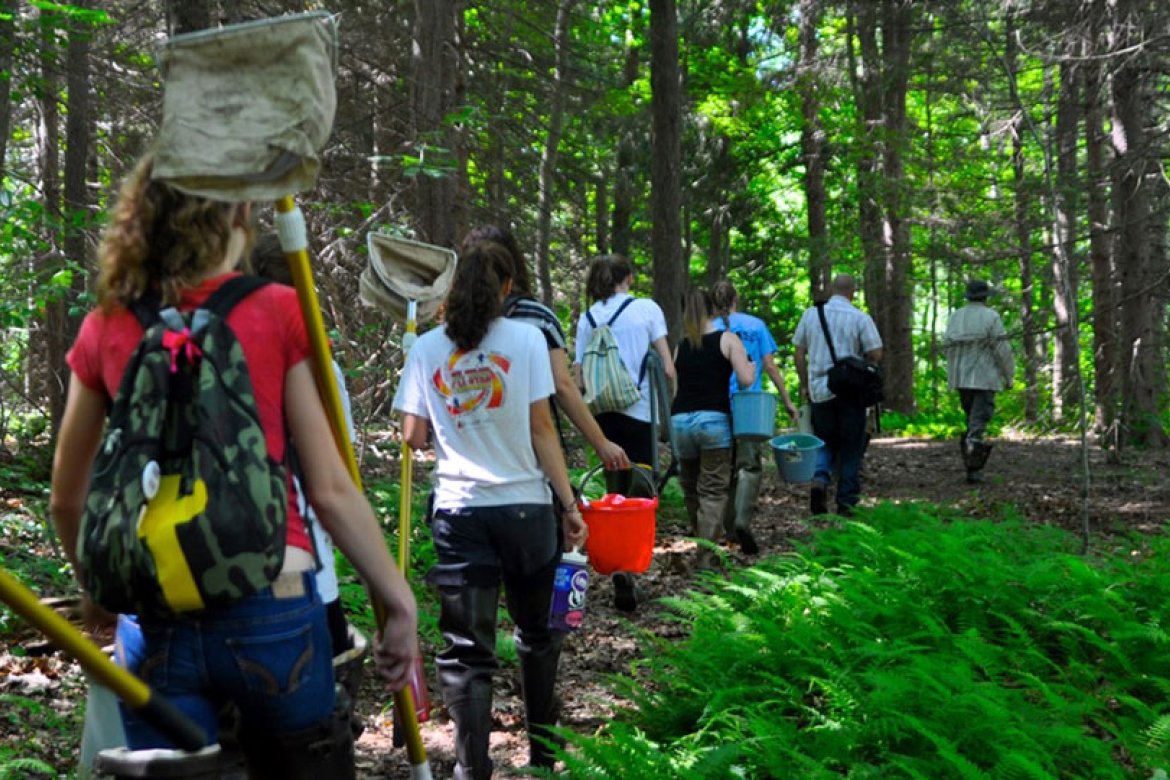A living classroom: restoring wetlands.

Mount Holyoke professor teaches ecology through wetlands restoration on campus.
By Keely Savoie
Early in the summer, one easily could have walked by the small stream running into Mount Holyoke College’s Upper Lake without ever noticing it. A wall of invasive vegetation obscured it, even though it lies mere feet from the path around the waterway.
The tributary and its surrounding land are the site of an ambitious ecological restoration project, known as Project Stream. Kate Ballantine, an assistant professor of environmental studies, launched the project this summer, after years of study and preparation.
Wetlands are essential for environmental and human health, according to Ballantine, reducing pollutants, replenishing water supplies, and providing habitat for countless species.
When the restoration of Project Stream is complete, all of the invasive vegetation will have been removed, and extensive plantings of native species will set a trajectory toward dominance by native vegetation. Water will meander slowly through the wetland, flowing over rocks and logs and interacting with wetland soil and vegetation, all of which will make it cleaner before it enters Upper Lake. There will be an accessible boardwalk, complete with interpretive signage, inviting visitors to experience the area for themselves. With multiple research projects continuing at the site, the area will be the very definition of an outdoor classroom for the local community and well as for professors and students at the College.
“It is incredibly exciting to arrive at this stage of the project, and I couldn’t be more proud of the accomplishments of everyone who has been a part of the restoration ecology program,” said Ballantine. “Dozens of students have dedicated extraordinary time, thought, and heart to this project, from its conception to the final project designs. Future students will get to continue this work by contributing studies of their own as well as by researching how the site functions and changes over time.”
Ballantine sees the field of restoration ecology as more than repairing degraded sites, though.
“Our students want ways to pursue ‘purposeful engagement in the world,’ but so much of what they learn about issues of environmental degradation and social injustice can leave them feeling discouraged,” she said. “Restoration ecology is an optimistic and empowering field, asserting that problems can be addressed and that humans have the capability of making positive change. It shows that we can take care of where we live and what we love.”
Students are continuously and seamlessly engaged with the project, and able to transfer their ideas directly from field to classroom and back again.
“It’s pretty unique to have a field site that is literally a five-minute walk from our classroom,” said Erin Pierce ’15, an environmental studies major who joined the project in its second year. “It gives what we do an immediacy that you really can’t get from most college field stations that are located off campus.”
Perhaps the restoration ecology program’s greatest impact is the practical training it provides to students for their future work and research. From their first day in class, Ballantine’s students learn skills in observation and developing research questions. Later, they learn to design real-world projects with tangible consequences, to work collaboratively, and to communicate their findings.
“Not a lot of students come out of college with all these skills—but our students have been doing it from day one,” said Ballantine. “They have gone from being consumers of information to producers of knowledge.”
Ultimately, Ballantine hopes Project Stream will be the first of many ecological restoration projects at the College. She has worked with students to identify other potential sites to restore across campus.
“Given Mount Holyoke’s liberal arts mission and on-campus field station, we are a destination for students eager to learn this interdisciplinary, international, and growing field in need of thinkers,” Ballantine said. “Participating in this program empowers students to be able to care actively for the natural systems and human communities they love.”
What’s your passion? Dig into it here.